Gamtoos farmers' annual water allocation slashed by 60% as dams dry out
Starting July, more than 200 citrus, vegetable and dairy farms in the Gamtoos River Valley that rely on water from the Kouga Dam will have their annual water allocation for 2017/18 slashed by 60%, the Gamtoos Irrigation Board (GIB) has announced.
The decision to allocate farmers just 40% of their annual water allocation, taken by the Department of Water Affairs, comes as the dam reaches 18.6% capacity – a level last witnessed in late 1991. It sank to the 9% mark in early 1992, after which that drought was finally broken.
According to GIB officials, just 2mm of rain fell in the Kouga Dam’s catchment area from April to June this year.
“We met with the department yesterday [June 29] and the GIB met this morning to discuss the allocation cuts,” said GIB chairman Tertius Meyer. “On the one side there is slight relief, as we expected a bigger cut than 60%. There is, however, also concern, as there is only 18% of water left in the dam.
“The hope is that, according to the allocation cuts and long-range weather forecasts, that the dam will hold more water this time next year.”
Meyer said the water allocation was usually communicated by the department a month in advance.
“We have farmers who have big commercial contracts with supermarkets who need to plan well in advance, so this was very short notice for them,” he said. “Now the question is do they split their 40% allocation over 12 months, or do they use it up in July and August and hope for good rains during the traditionally high rainfall months of September/October.”
STRICKEN FARMERS
For the affected farmers, the cut in water allocations is dire. GIB board member Rudolf Rose grew up in the region and farms maize, lucerne and vegetables.
“On a full water allocation, we are able to plant 350 hectares of combined crops annually,” said Rose. “With the reduced allocation, we will be lucky if we even plant 160ha. If that’s the case, we will have to concentrate on our higher income crops that are less water intensive, such as pumpkin and butternut.
“The lucerne will survive, but we’ll get no yield from that crop. The maize is too water intensive to plant. Even with a full allocation of water in 2016/17, we battled because of the very low rainfall. Now the dam is low, and that is our last line of defence.”
POSSIBLE JOB LOSSES
Jobs also hang in the balance.
“If farmers can’t plant their full allocation of crops, there is no need for a full quota of staff,” said Rose. “We operate with a fairly small contingent of staff, and I have not had to cut back yet.”
Rose’s neighbour and fellow GIB board member Jacques du Preez focuses on sweet potato, carrots, maize and wheat, and employs up to 40 staff.
“I’ve been farming for 20 years. We took the decision in April not to plant maize for 2017/18, and to cut back slightly on the rest of the crop production. We will then use our water allocation for 2017/18 to get that crop to harvest in August/September.
“If by then there have been no further rains, there is no Plan B. We’ll have to cross that bridge when we come to it, but I am staying positive,” said Du Preez.
WATER SAVINGS CRITICAL
The crisis has escalated the importance of savings for the irrigation board, which on June 16 embarked on a 16-day maintenance and repair shutdown of its main canal leading water from the Kouga Dam to the Loerie Dam – which feeds the Nelson Mandela Bay metro – and surrounding farms.
The annual shutdown of the 69km canal – and, at staggered intervals, the other 45km of branch canals – has become key to the irrigation board keeping its water losses low. Over the past year GIB has reported water losses of just 7.5%, mainly from leaks and evaporation – down from 13% in 2008 when it received a national accolade for water savings.
GIB’s losses are also dramatically lower than cities such as the Bay metro, which reports annual losses of between 30 and 40%.
“We have a robust water management system,” said GIB CEO Pierre Joubert. “When a leak is reported, we aim to address it within the hour.”
Joubert said GIB wanted to reduce losses even further through the refurbishment and replacement of ailing infrastructure.
“Our infrastructure was laid in 1970, so it requires ongoing maintenance,” he said, adding that the irrigation board spent R23-million annually on maintenance and operations.
GIB financial manager Rienette Colesky said the consistent maintenance of the irrigation board’s infrastructure was key to reducing water losses.
“We have quite an advanced water management and metering system, which also helps keep water losses low,” said Colesky. “For us, being pro-active in maintaining our infrastructure has been a key driver in our success.”
Main image: GOING DOWN: The Kouga Dam stands at just 18.6% capacity – levels last witnessed in 1991. Farmers drawing water from the dam have had their allocations for 2017/18 slashed by 60% from July 1. (Image: Supplied)

DIRE: The Kouga Dam stands at just 18.6% capacity – levels last witnessed in 1991. Farmers drawing water from the dam have had their allocations for 2017/18 slashed by 60% from July 1. (Image: Supplied)

DIGGING DEEP:Gamtoos Irrigation Board employees lay a new irrigation pipeline leading from the main canal to a farm (Image: Supplied)

MAINTENANCE:Gamtoos Irrigation Board senior water control officer Andrew Murray shows repair work done to the 69km main canal, which leads from the Kouga Dam to the Loerie Dam and surrounding farms. The canal has been drained for two weeks for its annual repair and maintenance. (Image: Supplied)

CLEANING UP:Gamtoos Irrigation Board employees have embarked on the annual two-week repair and maintenance of the 69km main canal which leads from the Kouga Dam to the Loerie Dam and surrounding farms. (Image: Supplied)
Related Stories
Police in Mt Fletcher have appealed to the public...
The South African Revenue Service (SARS) has...
It’s showtime at The NEiGHBORHOOD BAR & GRILL...
Policy conferences of South Africa's governing ANC have been about economic policy matters. But more recently organisational renewal has also dominated, as the party loses support...
Nelson Mandela Bay Executive Mayor Athol Trollip has...
Persistent efforts made by our members and...
Corobrik and five other brick makers have been...
In 2015, Nelson Mandela Bay local, Wayne Bolton...
The South African National Roads Agency SOC Ltd...
Believed to be the oldest African penguin in the world...
 More illegal firearms and ammunition seized by Eastern Cape police in the past week
More illegal firearms and ammunition seized by Eastern Cape police in the past week Investment scams: Fraudster disappears after swindling over 500 people
Investment scams: Fraudster disappears after swindling over 500 people Man goes on the run after stabbing his mother and aunt to death in front of toddlers
Man goes on the run after stabbing his mother and aunt to death in front of toddlers Two cars won at The Boardwalk this weekend
Two cars won at The Boardwalk this weekend Police warn stokvels after cash heist in Humansdorp
Police warn stokvels after cash heist in Humansdorp












